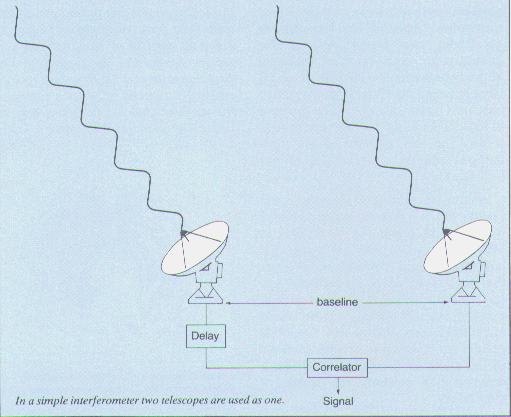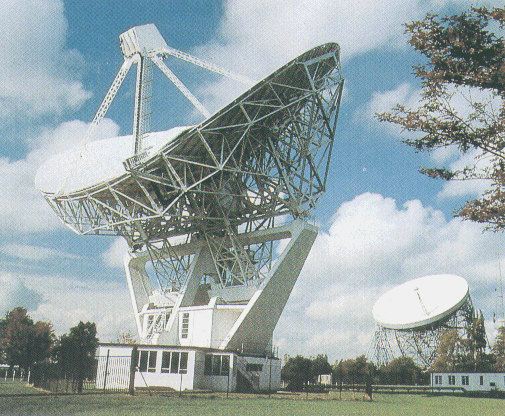

Large steerable reflectors like the Lovell Telescope are very efficient at collecting the weak radio waves that come to us from the cosmos,but they are not so good at discerning fine detail in radio sources. In fact,the human eye is more acute than the Lovell Telescope.
The resolving power of a telescope depends on the width of its collecting aperture compared to the wavelength at which it operates. Radio astronomers are at a disadvantage compared with their optical colleagues, because radio waves are many thousands of times longer than light waves. To achieve the same resolution,a radio telescope needs to be correspondingly bigger than an optical telescope.Under favourable atmospheric conditions the largest optical telescopes can attain resolutions of better than one second of arc, good enough to distinguish between a pair of car headlamps at a distance of 300 kilometres. To have the same resolving power at a typical wavelength of 20 centimetres, a radio telescope would need a dish more than 40 kilometres in diameter.
Rather than trying to build ever larger dishes, radio astronomers have solved this problem by the technique of interferometry. The basic idea is that two small telescopes can be made to imitate a much bigger telescope by linking them electronically. The imaginary line drawn between the telescopes is known as the baseline. Each telescope observes the same radio source, and the signals are brought together and blended to achieve a resolving power equivalent to that of a single large aperture of width equal to the baseline. In principle there is no limit to the length of the baseline, provided that the signals can be brought together.

A portable telescope from Jodrell Bank set up for early interferometric
observations at Pocklington in the Yorkshire Wolds
In an extension of the basic technique, several telescopes can be linked together to form an "array". Each telescope can be thought of as a small segment of a much larger dish. During the course of a day the rotation of the earth causes each telescope to sweep out a complete ring of the large aperture. By moving the telescopes every day,the whole aperture can eventually be filled. The signals can be processed by computer to make a picture of the radio source, whose resolution depends on the longest baseline in the array. This method of "aperture synthesis" was pioneered by Sir Martin Ryle at Cambridge University in the 1950s, and is now used in some form at all large multi-telescope arrays.

An illustration of simple interferometry.
Interferometry experiments began at Jodrell Bank in the 1950s. Small, portable telescopes were set up at increasing distances from a base telescope at Jodrell Bank. The telescopes were connected first by cables and then by microwave radio links, as the small telescope was moved to greater and greater distances. By the early 1960s a 25-metre telescope at the Royal Signals and Radar Establishment at Defford in Worchestershire had been linked in through a series of permanent relay stations extending the baseline to 127 kilometres.
| In the mid-1960s the Lovell Telescope was joined by the Mark II and Mark III telescopes. The mark II, also at Jodrell Bank, has an elliptical bowl measuring 25 x 38 metres; its sister telescope, the Mark III, is the same size but of a lightweight mesh construction. It is based 24 kilometres away at Wardle near Nantwich, and controlled remotely from Jodrell Bank. All three were used as interferometer elements, and the experience gained with them paved the way for a much more ambitious project MERLIN. |  Some of the dishes of the Ryle Telescope - a 5-kilometre array of telescopes at Cambridge (Keith Papworth). |

The Mark II and Lovell telescopes working together as an interferometer.